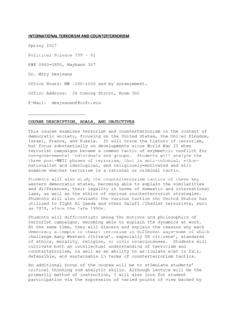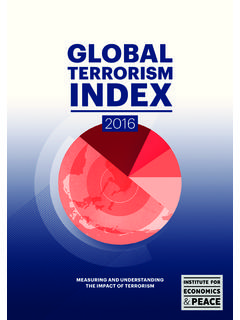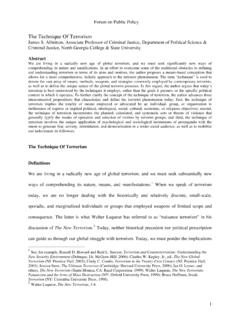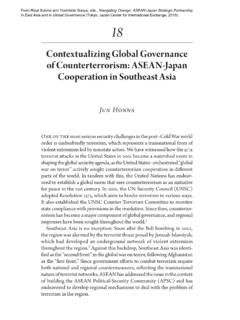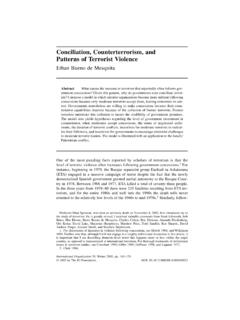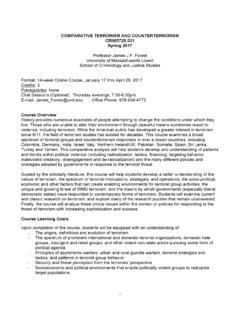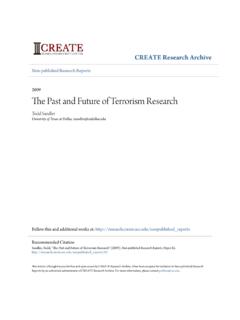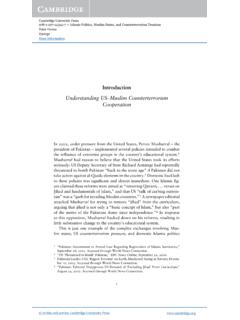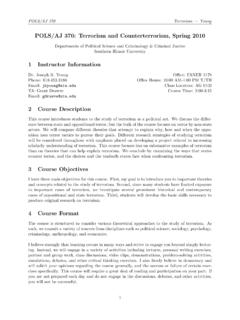Transcription of An Empirical Analysis of Terrorism in the Middle East and ...
1 An Empirical Analysis of Terrorism in the Middle east and Africa 1 An Empirical Analysis of Terrorism In the Middle east and Africa Isaiah Corbin Wartburg College Dr. Bret Billet An Empirical Analysis of Terrorism in the Middle east and Africa 2 Abstract Since President Bush declared War on Terror, counterterrorism policies have taken up a significant amount of resources. The lack of understanding the root causes of Terrorism is a serious problem. This study empirically tests the effects of political rights, human development, and type of government on the number of terrorist attacks in the period 2000-2005 in the Middle east and Africa. The political rights index, human development index, and polity score were measured as the independent variables and analyzed using regression and correlation Analysis . The level of development measured in GDP per capita, regime durability, conflict, and the size of the country measured in population were used as control variables.
2 The lack of political rights and greater human development decreased the number of terrorist attacks, where the type of government was not significant. Furthermore, GDP per capita, regime durability, the country s region, and total population size did not significantly affect the number of terrorist attacks. An Empirical Analysis of Terrorism in the Middle east and Africa 3 An Empirical Analysis of Terrorism in the Middle east and Africa I. Introduction and Literature Review Since 9/11, Terrorism has taken up a considerable amount of the United States resources. It has also become a key foreign policy problem, with the potential of a small group of individuals inflicting major damage in the form of casualties and treasure. These fast-evolving trends constitute a clear and present danger to the security of civilization (Victoroff, 2005, p. 3). Various methods and policies have been put forth to prevent and deter Terrorism after President George W.
3 Bush declared War on Terror ( Transcript, 2001). Several different forms of policies have been implemented to prevent Terrorism , including military action, economic sanctions, and diplomatic efforts. America s long war against Terrorism has been going on without much serious public debate about the true motivation of terrorists. Emotions such as fear and anger created by Terrorism are blocking the patience needed to form serious policies directed at the root cause of Terrorism (Pape & Feldman, 2010, ). The pressing threat is not Terrorism , but how we understand the cause of Terrorism . The lack of understanding can and has created ineffective counterterrorism policies. counterterrorism policies involve either taking a direct action approach or a defensive approach. A direct action approach includes destroying terrorist training camps, retaliating against a state sponsor, gathering intelligence, or freezing the terrorist s assets. A more defensive approach involves preventative measures like technological barriers ( , metal detectors and bomb detectors) and the securing of borders (Arce & Sandler, 2005, p.)
4 184). Much of the policy going into counterterrorism is based on a direct action approach. It is important that An Empirical Analysis of Terrorism in the Middle east and Africa 4 the actions taken are targeted effectively at the root cause of Terrorism in order to prevent terrorist actions before they happen. The number of options taken depends on the human, financial, and political resources the United States is prepared to invest. The lack of unlimited resources means that policy needs to be adaptive to the specific factors that cause Terrorism . The goal of this study is to look at several different variables and analyze what factors drive Terrorism in order to gain a better understanding where resources should be apportioned, in order to form a better counterterrorism policy. Definitions of Terrorism are controversial due to problems of labeling actions as Terrorism promotes the condemnation of the actors, which may reflect ideological or political bias (Gibbs, 1989, p.
5 329). For this study, we will use a broad definition of Terrorism as defined by the Global Terrorism Database (GTD). This will help us take a more inclusive look at Terrorism and will not exclude cases based on biases. Terrorism is the the threatened or actual use of illegal force and violence by a non state actor to attain a political, economic, religious, or social goal through fear, coercion, or intimidation. The victims or objects of terrorist attack have little intrinsic value to the terrorist group but represent a larger human audience whose reaction the terrorists seek (Crenshaw, 1981, p. 379). It is important to understand that terrorists are rational actors (Li& Schaub, 2004, pp. 233-234). They have a specific purpose for their use of violence and anticipate that it will create a reaction from the audience that they are targeting. Rational choice theory states that terrorist actions comes from a conscious, rational, and calculated decision, in order to accomplish a specific sociopolitical goal (Victoroff, 2005, p.
6 14). Many people use premeditated actions in order to accomplish a specific goal. The question is why some individuals or groups turn to violence while others do not. Are certain factors or environmental conditions more prone to push individuals or groups to violence? An Empirical Analysis of Terrorism in the Middle east and Africa 5 Terrorism has been mostly approached from a historical perspective. This has led to a lack of theoretical Analysis on the causes of Terrorism (Crenshaw, 1981, p. 379). This study will focus on two different theories to explain what drives certain individuals to use violence in order to accomplish their goals while others accomplish their goals with the use of violence. The first theory focuses on why people come to use violence. This can be explained by the Davies J-curve theory. According to Davies, revolutions, or in this instance Terrorism , are most likely to occur when a prolonged period of objective economic and social development are followed by a short period of sharp reversal (1962, p.
7 6). During the latter period, a mental state of anxiety and frustration manifests when expectations break away from anticipated reality (Davies, 1962, p. 6). The stability is dependent on a state of mind in a society. When a feeling of inadequacy, whether it is political or economic, becomes the state of mind and an unacceptable gap is produced as shown in Figure 1, violence breaks out. The gap is what pushes the terrorists to the point of no return and forces them to use violence in order to express their frustrations. Figure 1: Davies J-curve (Davies, 1962) An Empirical Analysis of Terrorism in the Middle east and Africa 6 The frustrated state of mind is important by the reasoning of frustration-aggression theory. According to this theory, aggression is the dominant response to the frustration of an ongoing response sequence (Galtung, 1964, p. 71). Furthermore, the frustration-aggression hypothesis literature suggests that coercive tactics may result in the instigation of political violence instead of preventing violence.
8 This insinuates that punishment could increase the likelihood that a frustrated group will respond in an aggressive manner (Shultz, 1979, p. 448). This has serious implications to how Terrorism is dealt with in the policy field. Unless one is able to prevent the outbreak of the frustrated state of mind, one will not be able to prevent Terrorism . Hence, the key to this study is the exploration of what factors cause this state of frustration. In order for Terrorism to occur, you need to presence of three things. First, there needs to be a concrete grievance. Second, there must be a lack of opportunity for political involvement. Third, an event must take place that provokes the outbreak of a terrorist attack (Crenshaw, 1981, pp. 383-384). It is important to understand what event is causing a terrorist to become frustrated and resort to violence. Should counterterrorism policies be more focused on economic or political reasons? A vast number of Empirical studies on Terrorism have looked at economic and political reasons, and there is still much debate over the impact of these two factors.
9 In the following pages, this study will look at previous studies to understand the root of the frustrated mind of a terrorist and what previous Empirical studies have found about the economic and political causes of Terrorism . Economic Analysis of Terrorism Previous Empirical studies looking at the impact of economic development are mixed. Li & Schaub have shown that the economic development of a country plays an important role in An Empirical Analysis of Terrorism in the Middle east and Africa 7 reducing the number of transnational Terrorism incidents within a country (Li & Schaub, 2004, p. 232). On the opposite side, Krueger & Male kov (2003) saw little direct connection between poverty or education and participation in Terrorism (p. 141). It is difficult to understand the economic reasoning behind the use of Terrorism . The prospect of individual economic gain by a terrorist is hardly justified, as they would become a target of the audience they attacked.
10 They may see the promise of larger payments to their families, as sufficient motivation to participate in Terrorism (Krueger & Male kov , 2003, p. 122). But there is very limited chance for economic gain of an individual using Terrorism which provides little reason for an individual to resort to using Terrorism for personal economic gain. There has been a widespread assumption that poverty creates Terrorism . This view is not shocking considering that much of the results from previous literature on the economic conditions of conflict suggest that poverty increases the probability of violence (Abadie, 2006, p. 50). Abadie (2006) found a significant association between Terrorism and economic variables, such as income (p. 55). Li and Schaub (2004) found evidence that Terrorism is associated with poverty (p. 232). Poverty is closely related to the education level. Generally, educated people are more likely to be involved in the political process.
